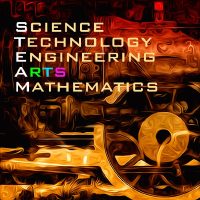The Tug of War Over STEM vs. STEAM
A MiddleWeb Blog

The eventual outcomes of this debate may seem less than earth-shattering, but with the pressing need for more highly skilled STEM professionals in the workforce, the decisions we make about the best use of educational resources could have economic and social aftershocks for decades to come.
Thinking about STEM
First, remember the why and what of STEM education. Both private and public sectors report that 21st-century workers require skills that many of today’s graduates don’t have. Students need more in-depth knowledge of math and science, plus the ability to integrate and apply that knowledge to solve the challenges facing our nation. And children who study STEM develop a variety of skills that are essential for success: including critical thinking and problem solving, creativity and innovation, communication, collaboration, and entrepreneurship, to name a few.
Our job as K-12 educators is to prepare our students for the world they will enter upon graduation. To meet those needs, K-12 STEM programs are being established to equip students with the specific 21st century knowledge and skills they need to be workforce and college ready.
A number of K-12 programs currently fly under the STEM banner. However, a 2014 study published by the America Society for Engineering Education identified several characteristics of quality STEM programs:
(1)The context is motivating, and engaging, and real-world.
(2) Students integrate and apply meaningful and important mathematics and science content.
(3) Teaching methods are inquiry-based and student-centered.
(4) Students engage in solving engineering challenges using an engineering design process.
(5) Teamwork and communications are a major focus. Throughout the program, students have the freedom to think critically, creatively and innovatively, and opportunities to fail and try again in safe environments.
STEM, then, is a specific program designed for a specific purpose – to integrate and apply knowledge of math and science to engineer technologies and solutions for real world problems, using an engineering design approach. To do that, it needs to maintain an intense focus on STEM courses.
Thinking about STEAM
Recently, the idea of adding the arts to STEM to form STEAM is gaining momentum. Interestingly, I’m hearing pushback on that idea from two camps.

2. From Arts proponents: Art draws us together with a power and beauty that lifts our spirits, elevates our thinking, and enriches our experiences. It’s the best part of what makes us human. Engineering and technology can certainly serve the artist and evolve the art. But if we’re talking about viewing art in our schools simply as a way to serve engineering, it seems we’re missing the point and devaluing or not realizing art’s purpose and importance. It seems we have it backwards.
So, can the arts fit into a STEM program in a way that does justice to both STEM and the arts? What would a STEAM program look like?
That’s what artist and educator-turned-STEAM-enthusiast Ruth Catchen is determined to find out. Ruth “gets it” regarding STEM; she currently works with a team of STEM writers and program developers who are using crowdfunding to develop and pilot a STEAM program in Colorado.
According to Ruth, the arts are a great learning tool and can serve as an on-ramp to STEM for underrepresented students. Engaging student strengths using arts activities increases motivation and the probability of STEM success. She views arts activities as a way of offering more diverse learning and greater access to STEM for all types of learners.
Art also provides diverse opportunities to communicate. Ruth believes that in our technically focused world, we have a responsibility to educate the whole child to become a global citizen in his or her community. She aims to do just that while staying true to the specific purpose of STEM education.
How do we solve the STEM-STEAM conundrum?
Let’s circle back to the question of how to include the arts in STEM in an authentic way. We could change the scope of STEM so that it focuses equally on learning in all subject areas—but why do that? We already have effective teaching methods for this: project and problem-based learning.
So let’s try another question. Can we combine art with just one of the STEM subjects—perhaps science—and ignore meaningful subjects like math and engineering? We certainly could—but that would be just art and science, not STEAM.
What about students doing personal STEAM projects? Again – that’s not faithful to basic STEM principles which always include teamwork, so would that be STEAM or just a good individual project?
Here, for what it’s worth, is where my thinking is now. Your ideas and pushback are valued and welcomed as I try to figure this out.

Performing arts such as drama and speech. What about technical or persuasive writing? Effective presentation? Those creative skills fit naturally into the “Communications” stage of the engineering design process. They would work well as part of a STEM project.
Creative planning. As students brainstorm solutions for an engineering problem, encourage them to adopt a playful, inventive, artistic approach. Calling on their artistic right brain can help them to generate more creative and innovative thinking.
Art is touted as a method of adding creativity to STEM, but keep in mind that engineers are not lacking for creativity and ingenuity. Our world contains many beautiful, useful, and imaginatively engineered creations. STEAM would not actually teach art (that’s for the art teacher to do) but would apply art in real situations.
An insight from Howard Gardner
All that to say, I don’t yet have a totally clear picture of what STEAM looks like. In my effort to find some clear examples, I came across a STEAM video that featured Dr. Howard Gardner, among others. I wrote to ask him if he had ideas for how to include art in STEM. He responded in a personal message: To answer your question in brief, I don’t have strong views about whether A (for arts) should become a part of STEM or be self-standing. What is important is that every human being deserves to learn about the arts and humanities, just as each person should be cognizant of the sciences.
I don’t think anyone can say it better than that. A STEM program is one part of a child’s education focused on math and science. Our children need a well-rounded quality education that enables them to make informed decisions that will impact the world and the way they live.
We need to educate students who are well-prepared and motivated to solve tomorrow’s STEM problems.
Note: This post is adapted and expanded from an earlier article I wrote for Education Week Teacher and the Center for Teaching Quality.
Credit: STEAM logo by Terry Williams





































STEM and STEAM. The possibilities are endless and very exciting! The wildcard in these discussions is the “A” for the Arts. The arts has within it one crucial element and that is to appreciate beauty. And having that appreciation, one can then create beauty. This lovely thing, beauty, is also within the STEM fields, but the A can help to bring this out so we can see and understand, and thus become better at science and technology, and more beautiful human beings.
I have a website, Biospherology.com, where I present a good deal of scientific information on developing an integrated approach to the study of the biosphere. I include pages on Biosphere Art and Biosphere Music. The art page presents metal sculpture of various animals and natural settings. Think of it: metals, welding, temperatures, alloys, heat coefficients, and sculpture. And of course, the beautiful and imaginative art works. On the music page, there is the Oceanic Visions, music depicting the feeling of the life of diatoms in the ocean. Think of it: microscopic life creating vast quantities of oxygen sustaining us, cellular structure, chemical reactions, and much more. This is STEAM to me.
Please visit at
http://biospherology.com/biosphere_art.htm
http://biospherology.com/biosphere_music.htm
Great article! I lean towards keeping it STEM as I agree with the point that arts are naturally included in STEM. I run afterschool STEM programs, and art is in everything we do. We are making prototypes of Mars colonies, and this allows for so much incorporation of the humanities. Another group is making a video on what they learned from rocket design. But I like keeping it as STEM as the A seems to over complicate and muddle understanding of STEM. It should be there if it fits that program, but not a requirement. Seems like we are just wanting to be politically correct or all inclusive if we add it, and then it looses meaning.
After reading Anne’s well thought out post and appreciating her ability to separate the issues to be so clear and well understood, I feel compelled to comment, if not only to add to my already quoted comments in this post.
It seems that whether it be STEM or STEaM depends on which side of the “a” you fall. Those who see the addition of social studies, language arts, the visual and performing arts and design as a natural part of STEM, tend to say why complicate things by adding the “a”? Just keep it STEM! Many of the “a” folks are plain and simply fighting for the arts and some, loathe the idea of STEaM as “arts lite”.
My goal is to include the “a” (small letter on purpose) because it enhances the educational value and at the same time, may include students who otherwise stand back from STEM. It really doesn’t matter what you call it—the need to create more students who are STEM literate and prepared for these careers for the future is well-documented.
So, it seems to me that we should stop arguing about which it is and just educate the whole child with the goal of creating STEM literate citizens prepared for the future. The idea is to break down the walls of the educational silos and create independent learners ready for career and/or college. The arts experiences do enhance our ability to think deeply about problems and be more empathetic. The arts additions create a different lens on science and math that make it more accessible to some and won’t take away from the rigor. Perhaps that is enough. Engineering design, using math, science and technology, must be the core of STEM or STEaM.
Again, I must reiterate that this idea of STEaM is not arts education. That (arts education) is a separate, valuable and equal discipline. Adding more creative elements to STEM or acknowledging them even though they already may be in place, only helps to create a well-balanced educational protocol. The one percent who may have the needed artistic talent to pursue the arts as a career will discover this ability more readily when arts are more available. For the rest, it serves as an enrichment to life’s experiences and helps to create audiences for the arts for the future. The arts add needed depth in learning experiences.
I believe that STEM education for all can open the doors for students to be ready for the future. Breaking down the walls a bit only offers a more comprehensive opportunity to include all students. My colleagues and I continue our pursuit to add the arts in a deliberate way and at the same time maintain the rigor of STEM education. We seek to define and create a replicable protocol that makes sense. I see this as an opportunity rather than a problem.
Thank you Anne for continuing to shine a light on STEM and STEaM.
Here is a quote worth pondering in the context of STEM and STEAM:
“…The humanities, and the arts in particular, stimulate, exercise and train the innovative side of our brains …without that exposure to the stimulus from education in the arts we do not fully develop use of the innovative power of the brain…”
from “Arts and the innovation gap” by Harvey White, former President of Qualcomm
Here is the link to the “Arts and the innovation gap” article:
http://www.utsandiego.com/news/2010/mar/11/arts-and-the-innovation-gap/
I completely agree about exposure to the arts! I was trained in classical piano, played in a band from high school through college, substitute on pipe organ for my church as needed, and regularly attend concerts and theatre events. My younger son is a talented musician and composer. I credit exposure to the arts with most of the beauty in the world.
My interest in the STEAM issue concerns whether the arts should be integrated into the STEM curriculum in their pure form. Certainly a type of art is integrated naturally, in terms of architectural design work and industrial design. I believe we should make that more explicit. I’m really at a loss to figure out how to seamlessly integrate pure art into a 45 minute STEM class, and who should do that? What are the creative elements that should be included in a STEM class, and how would that look? I’d appreciate some help with this one.
It’s been a while since these comments were made, but the subject remains timely and important.The take-away I have from Gardner’s reply is that it can be STEM or STEAM, but the “A” and the “STEM” should be part of everyone’s education, whether on one day it’s ST, next it’s EM, then STM, and the following week it’s STEAM (not to leave out other subject areas, but just to address this issue). I do agree that the integration of the art/s should be made explicit, not implicit, and the best way I know how to do this is to utilize the standards that many of us use to guide lessons and units, and include the NGSS, CCSS, and NCAS in alignment when we develop our materials. This is a straightforward way to ensure the inclusion of rigorous content and to assess student growth with vigor.
Insightful comments, Lisa. Thanks! I agree that the standards must be implicit in STEM lessons. One thing I’m trying to work with is the perception that if we teach ST, we are teaching STEM. Or, more commonly, if we teach SM, we are teaching STEM. The E – the engineering application – is the heartbeat of STEM. I see STEM as an integrated and intentional application of math and science standards-based content. It can’t be in every lesson, but at least in a quarterly engineering challenge. Does that fit with your thinking?
I just wrote a post around my latest thinking. It’s http://www.middleweb.com/33039/how-do-we-integrate-stem-across-subjects/ if you care to take a look.
Thanks, again, for your comments.